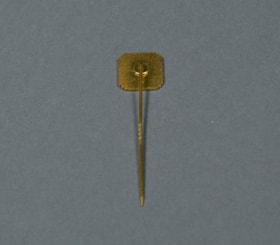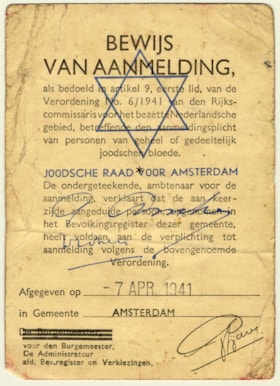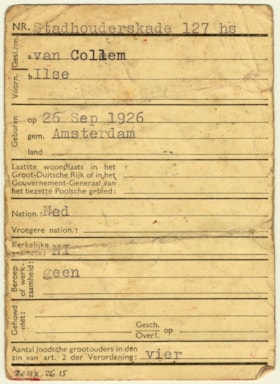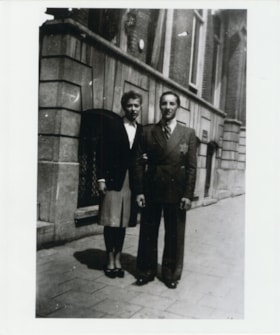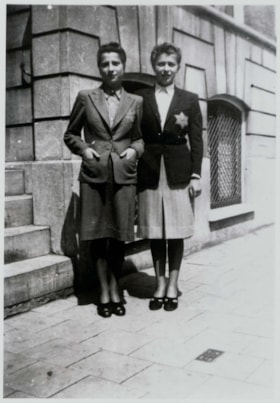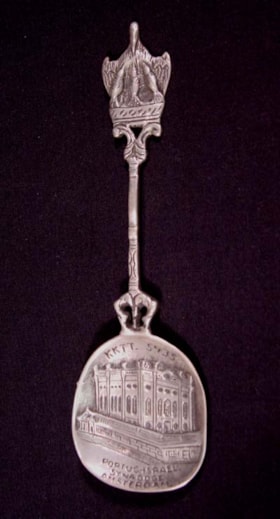Narrow Results By
Pin
https://www.cjhn.ca/link/cjhn47488
- Collection
- Montreal Holocaust Museum
- Description Level
- Item
- Material Type
- object
- Physical Description
- Pin : soldered, enamelled, inlaid, moulded, screwed, glued : gold, red, white, blue
- Collection
- Montreal Holocaust Museum
- Description Level
- Item
- Material Type
- object
- Physical Description
- Pin : soldered, enamelled, inlaid, moulded, screwed, glued : gold, red, white, blue
- Other Title Information
- Personal Symbol
- Physical Condition
- Good
- Notes
- Boxing pin. Square base with saw-tooth cut corners and a thin gold border at each edge. The centre has been divided horizontally 3 times (red, white, blue). Inlaid in the red is gold text (see inscription); inlaid in between the white and blue stripes is a pair of gold boxing gloves. The reverse is textured with a long, stick pin extending downwards from the centre; the middle of the pin has screw-teeth. Narrative: Medal was won by donor, David Kropveld. David Kropveld was born on January 3, 1918, in Amsterdam, Holland. David took up boxing as a young man and participated in competitions. In July 1940, David and his father joined the White Brigade resistence group in the south of France. As members of the White Brigade, David and his father gave up their Jewish identities. In October 1942, David was arrested while smuggling war-related information between occupied and Vichy France. He was tortured for ten days before being released. He was reunited with his father in Brussels, but the two were arrested by Gestapo officers one week later. They were incarcerated for three months and deported to Auschwitz concentration camp (Poland). Father and son wore the badges of political prisoners and were selected for the slave labour camp of Monowitz, where they stayed for about five days prior to being transferred to camp of Treblinka (Poland). In Treblinka, David witnessed his father’s murder at the hands of a guard. In the fall of 1944, a guard recognized David as a boxer he had admired and had him transferred back to Auschwitz and Monowitz in December 1944 to compete boxing matches against other prisoners. In December 1944, David managed to escape the death march with a few iother prisoners. He was rescued shortly after and brought to a hospital until his health improved. No members of his family survived the war. In the summer of 1945, David met his wife. In 1947, the couple emigrated to Cuba, and in 1950, to Montreal where David began a successful career as a butcher.
- Accession No.
- 1990.99.02
- Name Access
- Kropveld, David
- Archival / Genealogical
- Archival Descriptions
- Repository
- Montreal Holocaust Museum
Images
Residence certificate
https://www.cjhn.ca/link/cjhn90443
- Collection
- Montreal Holocaust Museum
- Description Level
- Item
- Material Type
- textual record
- Physical Description
- Residence certificate : Cardstock : printed, typed : Ink : beige, black, blue ; Ht: 4 1/8 in. x W: 3 7/8 in.
- Date
- April 7, 1941
- Collection
- Montreal Holocaust Museum
- Description Level
- Item
- Material Type
- textual record
- Physical Description
- Residence certificate : Cardstock : printed, typed : Ink : beige, black, blue ; Ht: 4 1/8 in. x W: 3 7/8 in.
- Other Title Information
- Documentary Artifact
- Date
- April 7, 1941
- Physical Condition
- Good
- Language
- Dutch
- Notes
- 1 page. Two-sided certificate printed and filled-in with a typewriter. On the recto, on t.c., the outlines of a blue Star of David on the center front page. The document gives information on Ilse van Collem's residence in Amsterdam. Narrative: The donor, Ilse Zilversmit, née van Collem, was born on 1926-09-26 in Amsterdam. Her father was a co-owner of a cosmetic business and a factory manager and her mother was a housewife. Ilse's family lived in a large house outside the Jewish quarter, where they received German Jewish refugees fleeing Nazism, after Hitler’s election in 1933. Ilse attended the same Jewish school as Anne Frank and became friends with Anne’s older sister, Margot. As anti-Jewish measures were gradually imposed in Amsterdam after the German invasion in 1940-05, Ilse was forced to pursue her education at home. On 1943-06-20, during one of the last great raids of Amsterdam, she was deported to the Westerbork transit camp. Ilse was detained for eight months at Westerbork transit camp where she worked on the farm and in the laundry. The van Collem family was then transferred to the concentration camp to Bergen-Belsen, where Ilse’s job was to dismantle German soldiers’ shoes and uniforms. A SS guard who felt sympathy for her had her transferred to kitchen duty where she had greater access to food for herself and her family. In 1945-03, her father was beaten by German guards because he was unable to remain motionless when ordered to stand at attention. He died of his wounds a few days later. On 1945-04-09, Ilse, her sister and her mother were again deported to an unknown destination. On 1945-04-23, the train was finally stopped, and its passengers were liberated by the Russian Army, near Leipzig, Germany. They were repatriated to the Netherlands by the Dutch Red Cross. Ilse met her future husband, Gunter Zilversmit, in The Hague in 1945. The two became engaged in 1947 and married in 1949. Their first child was born in 1950. Ilse’s husband was anxious to leave Europe. Because Ilse already had some friends in Canada, the family decided to immigrate to Canada on October 3, 1951 with the help of the Jewish Immigrant Aid Services (JIAS).
- Accession No.
- 2011X.26.15
- Name Access
- Zilversmit, Ilse
- Archival / Genealogical
- Archival Descriptions
- Repository
- Montreal Holocaust Museum
Images
Sam Schryver at entrance to Jewish district of Amsterdam
https://www.cjhn.ca/link/cjhn48387
- Collection
- Montreal Holocaust Museum
- Description Level
- Item
- Material Type
- graphic material
- Physical Description
- Photograph : Paper : Black, White ; Ht: 3 3/4 in. x W: 5 3/8 in.
- Date
- 1942
- Collection
- Montreal Holocaust Museum
- Description Level
- Item
- Material Type
- graphic material
- Physical Description
- Photograph : Paper : Black, White ; Ht: 3 3/4 in. x W: 5 3/8 in.
- Other Title Information
- Documentary Artifact
- Date
- 1942
- Physical Condition
- Excellent
- Notes
- Outdoors. Same Schryver stands at entrance to Jewish Quarter, large sign above him reads: ‘Juder Gracht Joodschegracht’.
- Accession No.
- 1995.18.01
- Name Access
- Schryver, Samuel
- Archival / Genealogical
- Archival Descriptions
- Repository
- Montreal Holocaust Museum
Images
Samuel Schryver and fiancée Jetty de Leeuw
https://www.cjhn.ca/link/cjhn45510
- Collection
- Montreal Holocaust Museum
- Description Level
- Item
- Material Type
- graphic material
- Physical Description
- Photograph : paper : black, white ; Ht: 25,4 cm x W: 21,5 cm
- Date
- 1942-1943
- Collection
- Montreal Holocaust Museum
- Description Level
- Item
- Material Type
- graphic material
- Physical Description
- Photograph : paper : black, white ; Ht: 25,4 cm x W: 21,5 cm
- Other Title Information
- Documentary Artifact
- Date
- 1942-1943
- Physical Condition
- Excellent
- Notes
- b&w, white border. Outdoors. Young man in a suit and tie and a well-dressed young woman standing on the sidewalk by a building in the Jewish Quarter of Amsterdam. He has a Star of David sewn on his jacket.
- Accession No.
- 1995.18.08
- Name Access
- Schryver, Samuel
- Archival / Genealogical
- Archival Descriptions
- Repository
- Montreal Holocaust Museum
Images
Schryver, Samuel - Oral History of a Holocaust Survivor
https://www.cjhn.ca/link/cjhn67762
- Collection
- WITNESS TO HISTORY COLLECTION (MHMC-02)
- Description Level
- Item
- Material Type
- moving images
- Physical Description
- 02:32:52
- Collection
- WITNESS TO HISTORY COLLECTION (MHMC-02)
- Description Level
- Item
- Material Type
- moving images
- Physical Description
- 02:32:52
- Language
- English
- Notes
- Sam Schryver was born on May 7, 1922 in Amsterdam, Netherlands. Sam describes pre-war Amsterdam as the “most beautiful Jewish area ... so warm ... [the] most beautiful place to live for a Jew ... this is gone and will never, never come back." Sam went to public school, but also attended religious school where he learned Hebrew. He had a traditional Jewish upbringing.His father was on a committee to help clothe the poor; and the entire family belonged to various synagogues and Jewish organizations. Most of the Jews in Amsterdam were concentrated in the centre of the city. Sam explains that he never experienced any antisemitism growing up and that many of his close friends were non-Jews. The Germans entered Amsterdam in May 1940. The Dutch Nazis began to organize more openly. One night 150 Dutch Nazis approached the Jewish quarter of the city. They were met, however, by 1 500 Dutch gentiles who came to defend the Jews. One Dutch Nazi was killed in the skirmish. As a reprisal, the German Nazis rounded up 400 Jewish boys and took them to concentration camps, either Mauthausen or Buchenwald. The Jewish neighbourhood was demarcated and all Dutch, Jews and non-Jews, had to register with the Nazis. Sam was able to get a job at a hospital, allowing him to be exempted from work camp. In September/October 1942, his father was taken to a concentration camp. Sam joined the resistance - he obtained false I.D. and ration cards for fugitives. During the great raid of May 1943 the Germans emptied all the hospitals and senior's homes - all patients (including his mother) and hospital employees were thrown into trucks to be taken to concentration camps. Sam managed to survive the great raid by going into hiding in The Hague. He spent 18 months in an attic until he was discovered and taken to a gestapo jail, "The Orange Hotel," where he was held from January 22 to February 2, 1945. He was then taken to Westerbork concentration camp. At Westerbork he worked in a factory that recycled batteries. He escaped and was picked up by the Orange Brigade - the allies thought Westerbork was a German army camp and was going to bomb it. Due to Sam's intervention, they delayed the bombing and sent a reconnaissance mission which confirmed his report that this was actually a concentration camp. The Canadian forces liberated Westerbork. Sam immediately joined the armed forces and volunteered to guard the German soldiers. He was relieved of his duties on June 22, 1945. He returned to Amsterdam where he joined a Zionist organization. Sam found out his parents had both been killed in Sobibor. One sister survived. Then he travelled the country looking for "Hidden Children,” preparing them for Aliyah. He did this until the State of Israel was proclaimed in 1948. He went into the textile industry and got his B.A. in Holland. In 1954, Sam immigrated to Canada because he had been liberated by Canadian forces. He did not want to create a family after seeing what had happened to his parents. His girlfriend was persuasive, however, and they have been married for 42 years.
- Accession No.
- WTH-124-1
- Name Access
- Schryver, Samuel
- Archival / Genealogical
- Archival Descriptions
- Repository
- Montreal Holocaust Museum
Images
YouTube
Schryver, Samuel - Oral History of a Holocaust Survivor
https://www.youtube.com/embed/TlyPQlTpN2gServicemen thank you letters to chaplain re: Religious courses, and centre
https://www.cjhn.ca/link/cjhn88889
- Collection
- Canadian Jewish Congress organizational records
- Description Level
- File
- Material Type
- textual record
- Fonds No.
- CJC0001; DA 18; DA 18-07-07
- Date
- 1945
- Description Level
- File
- Material Type
- textual record
- Date
- 1945
- Fonds No.
- CJC0001
- Series No.
- DA 18
- File No.
- DA 18-07-07
- Places
- Amsterdam
- Archival / Genealogical
- Archival Descriptions
- Repository
- Canadian Jewish Archives
SHUSTER, Rosa
https://www.cjhn.ca/link/genealogy102675
- Collection
- KENEDER ADLER
- Material Type
- textual record
- Archival / Genealogical
- Genealogy Records
- Collection
- KENEDER ADLER
- Material Type
- textual record
- Maiden Name
- Levinsky
- Name of Father
- Cantor A. Levinsky
- Spouse
- Name not specified
- Notice Publication Date
- 12/05/1933
- Place Where Deceased
- Amsterdam, Netherlands
- Age at Time of Death
- 23
- Notes
- Condolence notice: The Union of Cantors placed this noticed of Condolence to their member, Cantor A. Levinsky. Similar notice was placed on Wed. December 6 by the Russian-Polish Society. She died 3 weeks after her marriage.
- Record Source
- Yiddish Newspaper (Keneder Adler) Obituary
- Fonds No.
- I0042
- Archival / Genealogical
- Genealogy Records
- Repository
- Canadian Jewish Archives
Sisters Rachel and Jetty de Leeuw
https://www.cjhn.ca/link/cjhn48388
- Collection
- Montreal Holocaust Museum
- Description Level
- Item
- Material Type
- graphic material
- Physical Description
- Photograph : Paper ; Ht: 9 1/4 x W: 6 3/4
- Date
- 1941-1942
- Collection
- Montreal Holocaust Museum
- Description Level
- Item
- Material Type
- graphic material
- Physical Description
- Photograph : Paper ; Ht: 9 1/4 x W: 6 3/4
- Other Title Information
- Documentary Artifact
- Date
- 1941-1942
- Physical Condition
- Excellent
- Notes
- b&w photograph, outdoor, two women standing next to each other in the street next to a building's entrance. Location is the Jewish Quarter of Amsterdam. Both women are wearing a yellow star badge. Women are Herman de Leeuw’s sisters, on the left: Rachel (Shelley) and on the right Jetty (Henrietta).
- Accession No.
- 1995.18.02
- Name Access
- Schryver, Samuel
- Archival / Genealogical
- Archival Descriptions
- Repository
- Montreal Holocaust Museum
Images
Souvenir Spoon - "Portug-Israel Synagogue Amsterdam"
https://www.cjhn.ca/link/cjhn44213
- Collection
- CONGREGATION SHAAR HASHOMAYIM MUSEUM AND ARCHIVES
- Description Level
- Item
- Material Type
- object
- Physical Description
- Artifact : Silver ; Ht:12 cm x W:3.5 cm : English
- Fonds No.
- SH-01; 488
- Description Level
- Item
- Material Type
- object
- Physical Description
- Artifact : Silver ; Ht:12 cm x W:3.5 cm : English
- Fonds No.
- SH-01
- Item No.
- 488
- Physical Condition
- Very good
- Notes
- Top of spoon decorated with three birds; inscription "KKTT 5435 Portug-Israel Synagogue Amsterdam." Image of synagogue. Hallmarked.
- Places
- Amsterdam, Holland, Holland
- Archival / Genealogical
- Archival Descriptions
- Repository
- Congregation Shaar Hashomayim Museum and Archives
Images
Wedding picture of Salomon and Flora Schrijver (nee Mendels)
https://www.cjhn.ca/link/cjhn48391
- Collection
- Montreal Holocaust Museum
- Description Level
- Item
- Material Type
- graphic material
- Physical Description
- Photograph : Paper ; Ht: 19,4 cm x W: 25,4 cm
- Date
- 1942
- Collection
- Montreal Holocaust Museum
- Description Level
- Item
- Material Type
- graphic material
- Physical Description
- Photograph : Paper ; Ht: 19,4 cm x W: 25,4 cm
- Other Title Information
- Documentary Artifact
- Date
- 1942
- Physical Condition
- Excellent
- Notes
- b&w, white border. Outdoors, landscape format.Portrait of a bride (Flora Mendels, born October 15th, 1919) and groom (Salomon Schrijver) on their wedding day. Negative for this picture is Acc#1995.18.6-2 (Un,Rec#8445). The bride and groom are in the centre front of the picture. He is wearing a top hat, a white shirt with wing collar, a striped tie, a black coat with a white (?) flower on his lapel. On the left side of his coat is sewn a yellow star marked with the word Jood (Jew). Behind him on the left corner of the picture one can see the faces of one boy and one young man probably attending the wedding. His bride is standing on his left. She is wearing a white wedding dress whith a see-through neckline with applique white flowers and a white veil decorated with white fabric flowers. She is holding a bouquet of white (?) flowers. Behind her left shoulder one can see a woman who is probably part of the wedding party. Narrative: The wedding is taking place during the Nazi occupaton of the Netherlands. Jews in The Netherlands were forced to wear the star of David since May 1942. The wedding ceremony took place at the Great Synagogue of Amsterdam (known as the Great Shul). The ceremonial dedication of the synagogue took place on 25 March 1671. Theirs was one of the last weddings performed at the Great synagogue before the German occupying forces ordered the synagogue to close (September 1943). Salomon and Flora were first deported to the transit camp of Westerbork (The Netherlands) and from there to the death camp of Sobibor (Poland) where they were killed. Their approximate date of death is July 09th, 1943.
- Accession No.
- 1995.18.61
- Name Access
- Schryver, Samuel
- Archival / Genealogical
- Archival Descriptions
- Repository
- Montreal Holocaust Museum
Images
Yellow star badge
https://www.cjhn.ca/link/cjhn45478
- Collection
- Montreal Holocaust Museum
- Description Level
- Item
- Material Type
- object
- Physical Description
- Yellow star badge : yellow, black ; Ht: 3,75 in. x W: 3,5 in.
- Date
- May 9, 1942-May 5, 1945
- Collection
- Montreal Holocaust Museum
- Description Level
- Item
- Material Type
- object
- Physical Description
- Yellow star badge : yellow, black ; Ht: 3,75 in. x W: 3,5 in.
- Other Title Information
- Personal Symbol
- Date
- May 9, 1942-May 5, 1945
- Physical Condition
- Good
- Language
- Dutch
- Notes
- Piece of cloth in the shape of a six pointed star, printed with the outline of a Star of David. Fabric is stretched onto a cardboard support. Narrative: Flora Pfeiffer stretched the Star on cardboard and attached a sling to be able to change it on her uniform as a nurse. It was worn in concentration camps Westerbork (The Netherlands) and Bergen-Belsen (Germany).
- Accession No.
- 1990.88.01
- Name Access
- Pfeiffer, Flora
- Archival / Genealogical
- Archival Descriptions
- Repository
- Montreal Holocaust Museum
Images
{{ server.message }}


